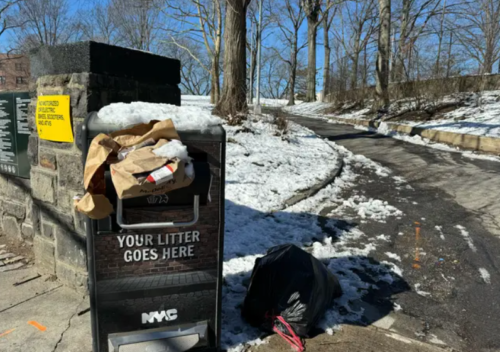
Lawmakers push for funding reform to clean up NYC’s most overlooked parks
By Ramsey Khalifeh
February 22, 2024
Overflowing garbage cans and debris-filled pathways are familiar sights for visitors to Claremont Park in the Bronx — but the parks department has limited money to clean things up.
The 38-acre park sits atop a hill in one of the city’s poorest neighborhoods, and has to compete for $29 million allocated this year for the maintenance and operations of more than 300 parks in the borough. Joe Thomas, a staffer at the park, said he’s one of just three employees tasked with keeping the space clean — but argues at least 10 people are needed to do the job.
“It’s something that’s always talked about among my coworkers, we’re under the gun,” said Thomas, 55. “We can’t keep up with the amount of trash that’s being put out here.”
That budget squeeze isn’t an issue for parks in some of the city’s wealthiest neighborhoods, which have nonprofit arms that raise millions of dollars to keep them nice and tidy. The Central Park Conservancy, which runs the city’s most famous park, brings in more than $140 million every year through donors, events and concessions, according to tax filings. And filings show that the Madison Square Park Conservancy, which presides over a significantly smaller park, generated nearly $5 million in the same year.
Advocates say this discrepancy divides the city's parks into the haves and have-nots, and it's raising calls for funding reforms by lawmakers.
The parks department itself brings in about $55 million a year from sources like concessions and permits, according to records. But due to rules in the city charter, that money isn’t retained by the parks department and is sent to a general fund instead. The funding for areas like Central Park, which keeps all the revenue it brings in, isn’t available to pay for maintenance at parks like Claremont. The city agreed in January to pay the Central Park Conservancy $160 million over 10 years to maintain and operate the park.
“Folks with power, they see places like Central Park or the High Line or others, and they say, ‘Wow, our city's parks are in great shape.’ And they make the assumption that the rest of the city's parks look like that,” said Adam Ganser, the executive director of New Yorkers for Parks, during a stroll at Claremont Park. “The reality is that they don't.”
Councilmember Shekar Krishnan of Queens, who chairs the Council’s parks committee, said he’s working on legislation that would allow parks to keep 80% of the money brought in by their own concessions and events. The other 20% would be made available to parks like Claremont, which only brings in revenue through a pair of seasonal food trucks.
“When our city significantly underfunds its parks, the harmful impacts aren’t felt equally across the city,” said Krishnan. “Where they’re felt most are in communities of color like my own that already have very little access to green space.”
At the state level, Assemblymember Jessica Gonzalez-Rojas of Queens is meeting with advocates to consider a plan that would generate more revenue for parks by adding a surcharge to tickets for stadiums located on parkland, like Citi Field and Yankee Stadium. She hopes to introduce a bill during the current legislative session.
“Many of the parks that have suffered the most are those that haven’t had the support in place of robust public-private partnerships to help offset some of those needs,” said Eli Dvorkin, a policy director at the Center for an Urban Future, which published a report in January laying out proposals for parks funding reforms.
The push for funding reforms comes as Mayor Eric Adams is proposing a 12% cut to the parks department. His executive budget proposal last month would reduce the department's funding by almost $100 million over the next two fiscal years, according to Krishnan’s office.